BY LINDA RAZZELL
I’m assuming you’ve already gasped at the Parc Güell, gazed at Gaudi, stared at the Sagrada Familia, and marvelled at Miró.
For me the charm of Barcelona is to be found in its more homely treasures, on foot or by its efficient public transport system.
The best way to arrive is by train, either the fast line from Perpignan, or, for an authentic frontier crossing experience (think spy novels), take the train round the coast.

You can’t buy a through ticket, but must spend half an hour in limbo in Cerbère, in the underground ticket hall, or gazing out across endless lines of disused tracks which once made up one of the busiest rail hubs in Europe. On joining the Spanish train, an armed frontier guard will minutely scrutinise your passport, then grin broadly and welcome you to Catalunya.
The train rattles along a scenic coastline of sandy coves and inlets to Figueres, where it picks up speed and gets you to Barcelona in an hour or so.
Get off at Passeig de Gràcia, more central and less frantic than Sants. From here the fast and efficient metro will take you anywhere you want, so buy a T-Ten travel card, having chosen a hotel in a location like the Raval, or Eixample, away from the noise of the main drags. Arrive on a Friday evening to give you plenty of time to explore, or, since Barcelona’s airports will be the only option for flights to the UK this winter, add it on to your Christmas holiday.
Get up early on Saturday morning and fortify yourself for sight seeing by a visit to La Donuteria, Carrer Parlament (metro: Poble Sec). This tiny twelve seater hole in the wall café is a real one off. The proprietor, Richard, is a tall American hipster who designs and makes his own artisan donuts, each one an art form in itself – you’ll want to be photographed with them! Not to be missed.
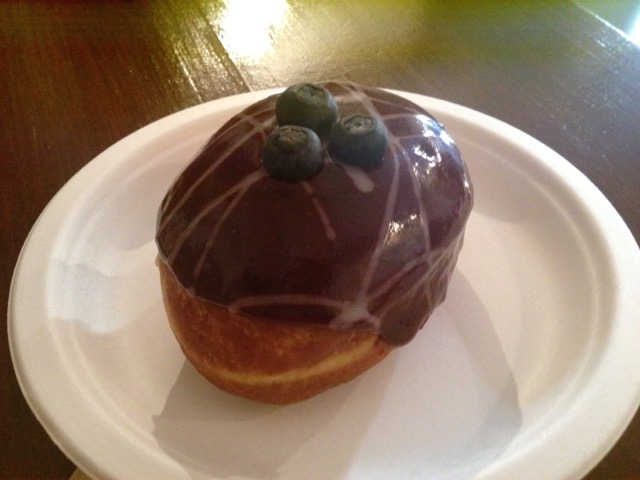
Roll on down past the magnificent Sant Antoni market building, still in the process of restoration. Temporarily, the stalls stretch down both sides of the street, and the tiny vibrant café won’t disappoint.
This market is every bit as good as La Boqueria, which you will soon pass – if you do go inside, please buy something! The market traders say that it has become a backdrop for selfies rather than shopping, and its future is in doubt.
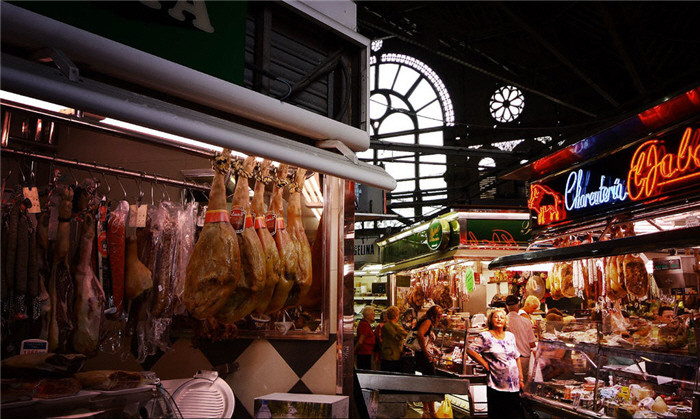
A little way along Sant Antoni, you will find the tiny Carrer de la Cera (candle makers’ street. Look in the window of number 7, Granja Puy. A fascinating antique shop? No, it’s a private house, but it’s worth ringing the bell if you fancy something in the window.
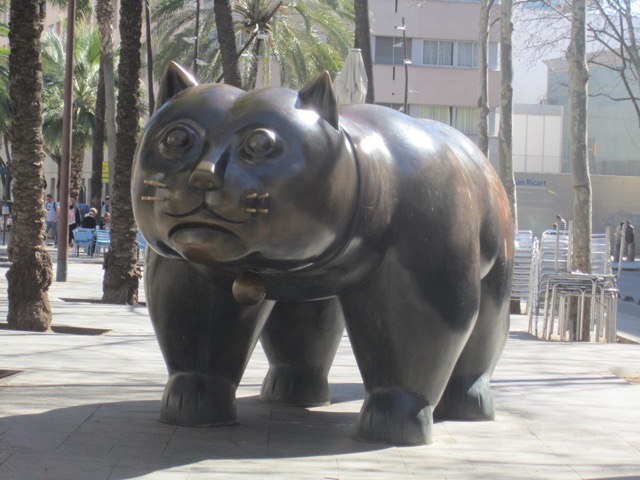
Passing through Raval, walk down its own modest Rambla, and stop to admire the statue of the cat.
There is a lot to see in the Raval, but you have to look carefully. For instance, on the wall of 17 Carrer de les Ramelleres (metro: Liceu) is a small hole, actually a pivoting window, known as el torn dels orfes (the orphans’ hole), where unwanted babies used to be left in the care of the nuns. It was in use until 1931.

Follow Carrer de San Pau and you are in el Barri Gotic, the oldest part of the city. At Carrer de Marlet in El Call, the ancient Jewish Quarter, you can go down into the remains of the Main Synagogue, dating from the 1st century.
It is tiny, as synagogues were not allowed to exceed 60 square metres. The streets are narrow here and the buildings almost meet overhead, but if you look carefully you can see the symbols and names of the ancient medieval guilds on the walls.
The Plaça Nova (metro: Jaume) opposite the Cathedral is a good place to begin following the Roman walls of the city on which Barcelona was built. The remains of the aqueducts are visible and just one of the sixty six towers is still standing. But even these well preserved ruins don’t prepare you for stumbling on one of the city’s best kept secrets.

Close by, at the end of the Carrer Paradis is a medieval building: go though its gate into a courtyard and come face to face with four columns of the Roman temple of Augustus. They are nine metres tall and date from the first century. They appear to be perfectly integrated with the houses they flank.
Time for lunch! No shortage of small local eating places here, or head north up the Via Laietana to the Palau de Musica Catalana. Eat at the café, then take the tour of this art nouveau concert hall with its fabulously decorated auditorium. Make sure you get there in time for some sunlight to be showing the coloured glass windows to maximum advantage (metro: Urquinaona).
You’re in Eixample now, and a couple of blocks away in the Carrer d’Arago is The Spy Shop (metro: Passeig de Gràcia). You will want your picture taken with the model outside.
Torre de las alguesStroll around the streets between here and Avinguda Diagonal, appreciating the facades of buildings like the Casa Granell, and finish up in the gardens of Torre de las Aguas, Carrer de Roger de Lluria (metro: Girona). Time to head back to the hotel and look for a dinner spot? Small restaurants off the main streets with a handwritten tapas menu outside will give the best value.
The place to be on Sunday is Barceloneta, once a fishing village and now the city’s playground.

But first take the funicular up to Montjuic (Metro: Paral·lel). Continue on the cable car up to the castle and make a quick turn around it. Gaze out across the Mediterranean over the container terminal, watch a passenger liner sweeping in to the new port, and a plane coming in over the fields of vegetables to land at El Prat. (Note how the cable car continues on, inching dizzily out over the sea, for a future trip).
Make your way back down the hill through the gardens, first stopping for a coffee at the restaurant Martinez, whose terrace gives one of the best view points in town. Spreading over the slope to your right is an impressive sight – the Necropolis, or city of the dead. Laid out neatly like a miniature housing estate, the nichos, or burial boxes, are stacked six high in ‘streets’ of well manicured stones and statuary. The trees are symbolic and have been specially chosen.
At the bottom of the slope, head for the Museu Maritim (Metro: Drassanes). The museum isn’t large, but it is magnificent. Most notable of its exhibits is a full size replica of a 16thcentury royal galley, the flagship at the battle of Lepanto.

In the garden is a replica of the first submarine, made out of wood by Narcis Monturiol, and resembling a barrel, possibly because his father was a barrel maker.
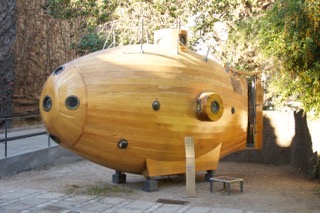
From here, cross the Rambla and follow the port round to Barceloneta and the sea front and take in the free entertainment: it could be a sandcastle Taj Mahal, complete with running water and a real fire, slack wire acts strung between two palm trees, a sousa band, jugglers, rope tricks – the world and his wife are here, skate boarding, roller blading, walking their dogs, eating and drinking, and having fun. There are numerous lunch opportunities along the beach walk.

When you reach the Fish, a massive piece of sculpture by Frank Gehry, designed for the Olympics in 1992 – you can’t miss it – turn inland and take the tram, up past the zoo to the Parc de la Ciutadella. Here you will find the elegant Castell de Tres Dragons among the fountains and waterfalls, plus a statue of a giant mammoth, bubble blowers, a boating lake, acrobats practising, balloon sellers, and on the bandstand – unless you are very unlucky – a tap dance troupe rehearsing their act, or something similar.
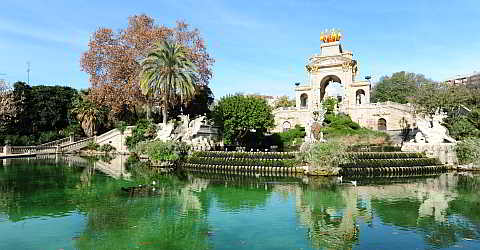
When you leave the park, walk back west along the Carrer de la Princesa, looking in the wonderful shop windows as the lights begin to come on. This is El Born, and it will return you to the Plaça de Sant Jaume, where, in a back street behind the cathedral, if you are lucky you may hear Marina, an opera singer, busking. Her voice wouldn’t be out of place in any opera house in the world. It’s a magical experience, a good way to finish the day before you get the train home.

